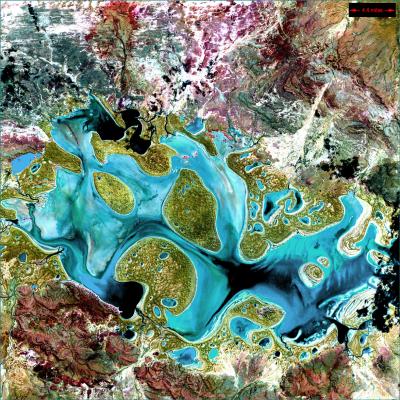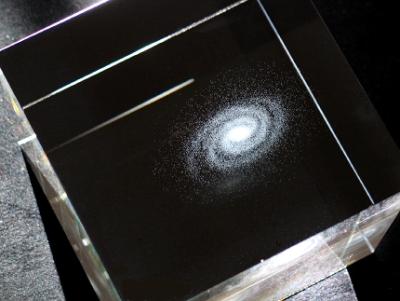Topic: Space - on October 14, 2008 at 11:10:00 AM CEST
Liebesgrüße aus dem All
Der Countdown läuft: An diesem Dienstag landen Aliens von der Förderation des Lichts auf der Erde - behauptet zumindest das Medium Blossom Goodchild. Nach Jahren heimlichen Wachens über Barack Obama und die restliche Menschheit wollen die Außerirdischen sich zeigen. Endlich.
Die gute Nachricht vorab: Die Aliens, die sich (wie eine steigende Zahl von Menschen rund um den Globus zu glauben scheint) bereits am Dienstag bei uns vorstellen wollen, kommen nicht, um die Erde zu erobern. Das hört man gern, aber es kommt sogar noch besser:
"Wir kommen, um eurer Welt zu helfen. Wir kommen nicht, um sie zu übernehmen. Wir kommen nicht, um zu zerstören. Wir kommen, um euch Hoffnung zu bringen."
Das - man beachte die Anführungszeichen - sagen die Aliens von der Föderation des Lichts selbst, und zwar durch das Medium Blossom Goodchild.
... Link (0 comments) ... Comment
Topic: Space - on October 2, 2008 at 12:33:00 PM CEST
A Stellar History: The Telescope Turns 400
Dutch eyeglass-maker Hans Lippershey first tried to patent the telescope in October 1608, and his invention was soon a big hit in Europe—as a tool for insider trading. Futures contracts were in vogue, and spying a cargo ship first had financial benefits. Oh, and the telescope also redefined our universe: In 1608, Earth was the center of God's perfect Creation. By 1610, Galileo showed that Jupiter had moons, Earth's moon had mountains, and the Catholic church was fallible. Four centuries on, we know we're a mere speck in a universe of wonders.

... Link (0 comments) ... Comment
Topic: Space - on September 16, 2008 at 11:43:00 AM CEST
Hubble Finds a Mystery Object
The project used the Hubble Space Telescope to monitor very distant galaxy clusters for supernovae. On February 21, 2006, in the direction of a far-away cluster in Bootes named CL 1432.5+3332.8 (redshift 1.112, light travel time 8.2 billion years), Hubble began seeing something brighten. It continued brightening for about 100 days and peaked at 21st magnitude in two near-infrared colors. It then faded away over a similar timescale, until nothing was left in view down to 26th magnitude. The object brightened and faded by a factor of at least 120, maybe more
... Link (0 comments) ... Comment
Topic: Space - on September 3, 2008 at 12:05:00 PM CEST
New Eye to the Universe Under Construction
The LSST, or the Large Synoptic Survey Telescope is a large survey telescope being constructed in northern Chile. When operational in 2015, it will be the widest, fastest, deepest eye of the new digital age, providing timelapse digital imaging across the entire night sky every three days, mapping the structure of our dynamic universe in three dimensions and exploring the nature of dark matter and dark energy. LSST hit a major milestone in its construction when the primary mirror blank was recently created. Project astronomers say the single-piece primary and tertiary mirror blank cast for the LSST is "perfect."
The 51,900 pound (23,540 kg) mirror blank was fired in the oven at the University of Arizona's Steward Observatory Mirror lab in Tucson, Arizona. It consists of an outer 27.5-foot diameter (8.4-meter) primary mirror and an inner 16.5-foot (5-meter) third mirror cast in one mold. It is the first time a combined primary and tertiary mirror has been produced on such a large scale.
LSST will have three large mirrors to give crisp images over a the largest field of view that will be available. The two largest of these mirrors are concentric and fit neatly onto a single mirror blank. LSST was recently the recipient of two large gifts: $20 million from the Charles Simonyi Fund for Arts and Sciences, and $10 million from Bill Gates. The finished mirror is scheduled to be delivered in 2012.

... Link (0 comments) ... Comment
Topic: Space - on August 1, 2008 at 11:59:24 AM CEST
Going For The Lunar X Prize? Want To Take Photos? NOAA May Require You To Get A License
The Google-sponsored Lunar X Prize has received plenty of attention. Similar to the original X Prize for a privately built manned spaceship, the focus of the Lunar X Prize is to get a privately built spaceship to the moon with a robot (so, unmanned), then have that robot travel 500 meters and then send video and images back to Earth. Cool, right?
... Link (0 comments) ... Comment
Topic: Space - on July 29, 2008 at 11:28:02 AM CEST
Branson unveils space tourism jet
The British business tycoon, Richard Branson, has unveiled an aircraft in the US that will be used for his project to launch tourists into space.
The high-altitude jet will act as the mothership for a spacecraft, releasing it in mid-air to take two crew and six passengers on sub-orbital flights.
More than 250 people have already paid $200,000 (£100,000) each to be among the first making the tourist trips.
... Link (0 comments) ... Comment
Topic: Space - on July 24, 2008 at 4:16:05 PM CEST
60+ Absolutely Stunning Space and Planets Wallpapers
Inspired by The Universe of History Channel on TV, I come to find that my time machine desktop wallpapers is already old and boring. In the search for another space/universe alike wallpaper, I happened to came across a lot of really nice ones. The launch of Mac OSX Leopard probably kicks these space wallpapers back to the trend.
In case you are looking for a fresh look for your desktop, try some of these space wallpapers. For starters try these 60+ absolutely stunning space and planets wallpapers (most in really high resolutions) I’ve found, starting off with 3 default space wallpapers that comes with Mac OSX Leopard.

... Link (0 comments) ... Comment
Topic: Space - on July 3, 2008 at 10:32:47 AM CEST
30 Most Incredible Abstract Satellite Images of Earth
“It is impossible to give a clear account of the world, but art can teach us to reproduce it - just as the world reproduces itself in the course of its eternal gyrations.” Albert Camus
Indeed, the world reproduces itself not only in the course of several gyrations, but at several different heights. At ground level, one can only imagine the sheer beauty of mountain ranges, deserts and deltas seen high up from NASA’s satellites. One can imagine - yes - however, they wouldn’t be quite prepared for the fact that from 400 miles away, the earth transforms into abstract art. The global landscape is impressionist, cubist and pointillist. Mother Nature is an abstract artist.

... Link (0 comments) ... Comment
Topic: Space - on June 3, 2008 at 3:00:41 PM CEST
Phoenix Mars website invaded by hackers
Add the webpages for the Phoenix Mars Lander to the list of high-profile sites that have been hacked by script kiddies. Not once, but twice.
Security pros had to take down the University of Arizona-hosted site after hackers replaced the lead blog entry with graffiti that read "hacked by VITAL." As if that wasn't enough, members of the self-declared "sql loverz crew" redirected baffled visitors of the Phoenix mission's official webpage and a companion site to a third-party destination. That page gave credit to hackers going by the names BLaSTER and Cr@zy_king.
... Link (0 comments) ... Comment
Topic: Space - on April 22, 2008 at 12:40:00 PM CEST
Beyond our solar system
The Milky Way galaxy suspended in a glass cube
Behold: a galaxy suspended in a glass cube.
A laser was used to etch around 80,000 of the stars in the Milky Way, using three-dimensional data from the Japan’s National Astronomical Observatory

... Link (0 comments) ... Comment
Topic: Space - on April 19, 2008 at 5:01:00 PM CEST
420 Kilometer vom Ziel entfernt
Nicht ohne Pannen - aber gerade noch glimpflich - ist am Samstag die Landung eines russischen "Sojus"-Raumschiffs mit drei Besatzungsmitgliedern der Internationalen Raumstation (ISS) an Bord verlaufen. Die "TMA-11"-Kapsel kam weit von ihrem Kurs ab und landete 420 Kilometer von ihrem Bestimmungsort entfernt in der kasachischen Steppe. Der Zustand der Astronauten sei "befriedigend", hieß es nach der harten Landung knapp. "Das Wesentliche ist, dass die Besatzung lebt."
... Link (0 comments) ... Comment
Topic: Space - on April 19, 2008 at 1:14:00 PM CEST
First signals from extraterrestrial civilizations arrived on Earth 40 years ago
The story has rather a commonplace beginning. British radio astronomer Antony Hewish – who was already well-known in the 1960s – asked his postgraduate Jocelyn Bell to make her own telescope to explore the sky and search for new quasars. With the help of her colleagues she coiled kilometers of wire around hundreds of wooden poles. Thus, she created a very sensitive aerial that subsequently began to receive strange signals on a regular basis.
At first Jocelyn thought that this was a form of interference from a military or commercial station located nearby. Afterwards, she started checking engineering data of her wire entanglements. In the end Jocelyn concluded that signals were of space origin.
Her advisor and she were even frightened at first when they thought about green aliens who sent them a coded message from the depth of space. For half a year they kept Bell’s discovery dark until they published a joint report on pulsatile signals in Nature magazine in 1968.
... Link (0 comments) ... Comment










